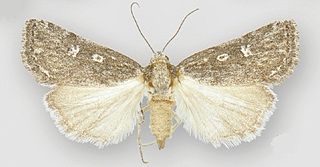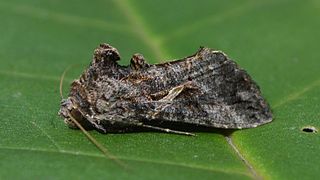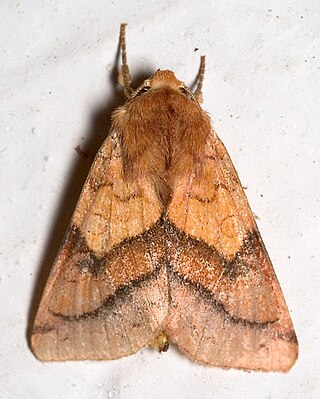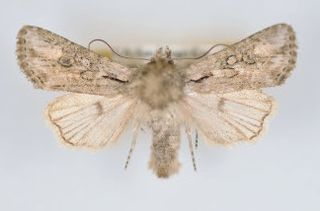
The Noctuidae, commonly known as owlet moths, cutworms or armyworms, are a family of moths. They are considered the most controversial family in the superfamily Noctuoidea because many of the clades are constantly changing, along with the other families of the Noctuoidea. It was considered the largest family in Lepidoptera for a long time, but after regrouping Lymantriinae, Catocalinae and Calpinae within the family Erebidae, the latter holds this title now. Currently, Noctuidae is the second largest family in Noctuoidea, with about 1,089 genera and 11,772 species. This classification is still contingent, as more changes continue to appear between Noctuidae and Erebidae.

Drasteria is a genus of moths in the family Erebidae.

Fotella is a monotypic moth genus of the family Noctuidae. Its only species, Fotella notalis, is found in the US in the Big Bend region of western Texas, southern Arizona, southern California and southern Nevada. The habitat consists of dry deserts. Both the genus and species were first described by Augustus Radcliffe Grote in 1882.
Mouralia is a genus of moths of the family Noctuidae, consisting of only one species Mouralia tinctoides. It is found from Florida to South-east Texas, Georgia, Southern California, the Antilles, from Mexico through Brazil to Northern Argentina and in Peru.
Apamea digitula is a moth of the family Noctuidae. It was described from the Laguna Mountains of San Diego County, California, in 2006. It is also known from western Oregon.
Apamea bernardino is a moth of the family Noctuidae. It is known only from the San Bernardino Mountains of California, where it lives in coniferous forests above 2000 meters in elevation. It was first described in 2000 from a specimen collected at Barton Flats.

Apamea scoparia is a moth of the family Noctuidae first described by Kauri Mikkola, Tomas Mustelin and J. Donald Lafontaine in 2000. It is one of the most common and widespread North American Apamea, being distributed from Newfoundland and Labrador to Alaska and British Columbia, and south to California and Arizona.
Schinia crotchii is a moth of the family Noctuidae. It is found from southeastern Arizona west to the Peninsular Ranges of southern California and north in south-eastern Washington and southern Idaho.

Ctenoplusia oxygramma is a moth of the family Noctuidae. It is found in southern Ontario, the eastern parts of the United States to Arizona. It has also been reported from Kansas, Nebraska, Iowa, Wisconsin, Mexico, the Antilles and from California south to Brazil and India Argentina.

Pyrrhia exprimens, the purple-lined sallow, is a moth of the family Noctuidae. The species was first described by Francis Walker (entomologist) in 1857. In North America it is found from Newfoundland and Labrador west across southern Canada to southern Vancouver Island, south to Texas, Arizona and California. Outside of North America it is found in Finland, the West Siberian plain, the South Siberian Mountains and Kazakhstan.

Panthea virginarius, the Cascades panthea, is a moth of the family Noctuidae. It is mainly found west and north of the Great Basin, from the coast of southern California northward to the Queen Charlotte Islands of British Columbia and the Alaskan Panhandle, eastward to central California, northern Nevada, Idaho, north-western Wyoming, western Montana, and south-western Alberta. A disjunct population is found in the Cypress Hills of Alberta and Saskatchewan.

Raphia frater, the brother moth or simply the brother, is a moth of the family Noctuidae. It is found from Nova Scotia west, across the forested regions of Canada to British Columbia, south to Mississippi in the east. The southern limits in the west are uncertain due to confusion with several closely related species or forms.

Aseptis ethnica is a moth of the family Noctuidae first described by John Bernhardt Smith in 1899. It is found in North America in Arizona, California, western Oregon, and Baja California Norte in Mexico. The habitat consists of open pine and oak forest and mountain chaparral, mostly at elevations of above 1500 meters in southern California but at lower elevations farther north.

Mesogona olivata is a moth of the family Noctuidae. It is found from southern coastal and interior British Columbia south through California, Colorado and Texas. It most likely also occurs in northern Mexico.

Eudryas unio, the pearly wood-nymph, is a species of moth of the family Noctuidae. It is found in most of the eastern United States from central New Hampshire and southern Ontario, south to southern Florida. In the west it ranges to the eastern Great Plains, south to southern Texas and Veracruz along the eastern coast of Mexico. There are isolated populations in central Utah and California. The California population might be considered a distinct subspecies or even species, brevipennis.

Lasionycta perplexa is a moth of the family Noctuidae. It is widely distributed from southern Alaska and Yukon in the north to California, Utah, and Colorado in the South. A disjunct population is found on the east coast of Hudson Bay at Kuujjuaraapik.

Lasionycta uniformis is a moth of the family Noctuidae. It is widely distributed in the mountains of western North America. It occurs from southern Yukon to northern California and Colorado, with an isolated population in eastern Quebec.

Fishia yosemitae, the dark grey fishia or grey fishia, is a moth in the family Noctuidae. It is found from central Alberta to Colorado in the Rocky Mountain and Great Plains regions. It is also found in eastern, central, and southern California, as well as in the Intermountain region. The habitat consists of dry open areas, including open ponderosa pine forests, juniper woodlands and sagebrush steppe at low to middle elevations.

Aseptis fanatica is a moth of the family Noctuidae first described by Tomas Mustelin in 2006. It is found in western North America in Washington, Oregon, California, and Baja California Norte in Mexico. It is found in habitats like brush land and open forest in southern California, mostly at 1000–2000 meters, but occurs at lower elevations farther north.

Aseptis torreyana is a moth of the family Noctuidae first described by Tomas Mustelin in 2006. It is found in along the south side of the sea level salt marsh estuary of the Torrey Pines State Reserve in southern California. The habitat is most likely salt marsh, although it could be coastal chaparral.













